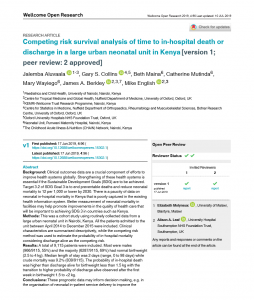
Background
Clinical outcomes data are a crucial component of efforts to improve health systems globally. Strengthening of these health systems is essential if the Sustainable Development Goals (SDG) are to be achieved. Target 3.2 of SDG Goal 3 is to end preventable deaths and reduce neonatal mortality to 12 per 1,000 or lower by 2030. There is a paucity of data on neonatal in-hospital mortality in Kenya that is poorly captured in the existing health information system. Better measurement of neonatal mortality in facilities may help promote improvements in the quality of health care that will be important to achieving SDG 3 in countries such as Kenya.
Methods
This was a cohort study using routinely collected data from a large urban neonatal unit in Nairobi, Kenya. All the patients admitted to the unit between April 2014 to December 2015 were included. Clinical characteristics are summarised descriptively, while the competing risk method was used to estimate the probability of in-hospital mortality considering discharge alive as the competing risk.
Results
A total of 9,115 patients were included. Most were males (966/9115, 55%) and the majority (6287/9115, 69%) had normal birthweight (2.5 to 4 kg). Median length of stay was 2 days (range, 0 to 98 days) while crude mortality was 9.2% (839/9115). The probability of in-hospital death was higher than discharge alive for birthweight less than 1.5 kg with the transition to higher probability of discharge alive observed after the first week in birthweight 1.5 to <2 kg.
Conclusions
These prognostic data may inform decision making, e.g. in the organisation of neonatal in-patient service delivery to improve the quality of care. More of such data are therefore required from neonatal units in Kenya and other low resources settings especially as more advanced neonatal care is scaled up.